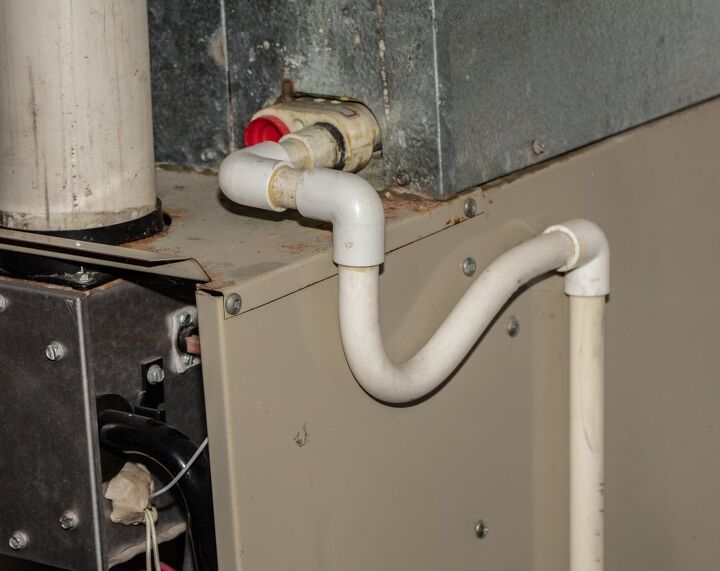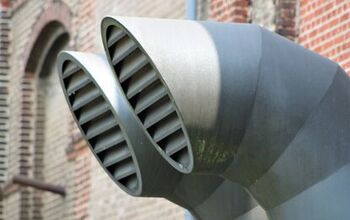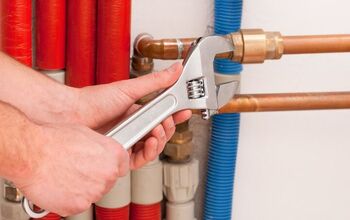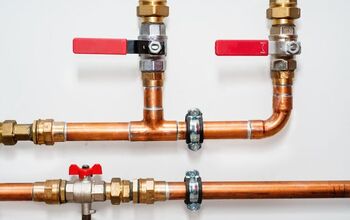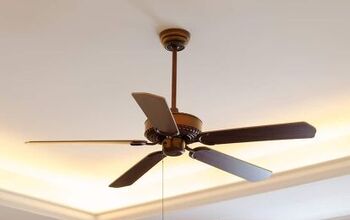Furnace Exhaust Pipe Dripping Water? (Possible Causes & Fixes)

During your regular monthly maintenance on your HVAC system, you notice something strange. Water seems to be dripping from your furnace exhaust pipe. You immediately wonder what is happening, why it is happening, and what you should do if you notice your furnace exhaust pipe dripping water.
Water leaking from a furnace exhaust pipe is a sign of bigger problems. If your furnace exhaust pipe is leaking water, it is also leaking combustion gases, including carbon monoxide and carbon dioxide. Both gases can be dangerous if they leak back into your house. There are several causes for water leaking from your furnace exhaust pipe and demand immediate attention.
Diagnosing an HVAC system problem that can cause water to drip from your furnace exhaust pipe is not difficult. There are some things you should know and understand about your HVAC system when looking for the problem with your HVAC exhaust system. While it may be easy to diagnose a problem with your furnace exhaust pipe, repairing the problem may require the services of a trained HVAC technician.
Do You Need Furnace or Heating System Repair?
Get free, zero-commitment quotes from pro contractors near you.

What Kind of Furnace Do You Have?
Before you try to diagnose a problem with the exhaust vent on your furnace, you must know which type of furnace you have. In general, residential HVAC systems come in two forms. Each of these types of residential HVAC systems presents a distinct set of potential problems.
In general, conventional furnaces vent all the combustion gases through the roof through a metal flue pipe that exits outside through the roof. These combustion gases include the toxic products of burning natural gas, butane, or propane. Water is also a component of this burning process.
Condensing furnaces capture this water and dispose of the condensed water through a drainpipe. This condensing process Happens in a secondary heat exchanger that captures the heat of the escaping gases to make your furnace more efficient. As the gases cool, the water condenses. The exhaust gases cool so much it is safe to use a plastic exhaust pipe in many cases.
Problems with Conventional Furnaces
First, you should understand that conventional furnaces should not produce any water at all. If your conventional furnace is leaking water from the exhaust vent pipe, you have a definite problem that needs attention.
A conventional furnace should exhaust the hot gases of combustion through the roof vent above your home. If the exhaust pipe leaks, the water vapor in the exhaust gases can condense on the vent pipe and leak back into your home. Leaks in the vent pipe have more dire consequences that demand immediate attention. The usual culprits leading to leaking and water accumulation include:
- Leaking humidifiers
- Improperly designed or installed vent pipes
- Clogged Drip Line on your AC coils
Some of these problems are related to your heating system. If your HVAC system is leaking water, this indicates a different problem.
Leaking Humidifiers
Many homeowners outfit their conventional furnaces with humidifiers. Gas-fired furnaces tend to remove much of the humidity in the air of your home. A bit of humidity in the air makes your home more comfortable. Adding a humidifier to your furnace replaces some of the moisture as the HVAC system operates.
Humidifiers work in different ways, but all require a source of water. It is this source of water that can become a problem. Humidifiers can leak at the connections, or the humidifier itself can corrode and leak. If you find water puddling around your furnace and you have a humidifier, check the water connections and the humidifier carefully for work.
Water can leak from different points in your humidifier. In general, the places most prone to leaks in these places.
- The water supply line and the connection to the humidifier
- The automatic valve that allows water into the humidifier
- The feed line that feeds water to the humidifier
- The humidifier housing.
A leaking humidifier requires a visit from a qualified technician.
Video: Why Does My Furnace Leak Water? Can I Fix It?
Improperly Designed Vent Pipe
Non-condensing furnaces vent the combustion gases out of the house and through the roof via a metal flue pipe. If the design or installation of the vent pipe is incorrect, the combustion gases won’t escape properly. The problems associated with a vent pipe that isn’t working include:
- The vent pipe may fail to vent the hot gases properly outside the house.
- Combustion gases may escape into the house
- Water may condense out of the combustion gases and leak back into the house
- The furnace may not operate properly because of the leak
If you have the least inclination that your flue pipe is not operating properly or the installation is incorrect, immediately call an HVAC technician to find and repair the problem. The danger of a leaking furnace vent pipe to your family can’t be overstated. Carbon monoxide and carbon dioxide are both lethal in concentration.
Condensing Furnaces – Look for the Clog
Condensing furnaces condense the water from the hot exhaust gases and send that water to a drain. In the process, the hot combustion gases cool to near ambient temperatures. After cooling, the vent pipe delivers the cooled gases outside through the vent pipe.
If you notice water around your condensing furnace, the obvious culprit is a leak in the drain system. Plumbers typically use plastic pipe (PVC) to plumb the collection system from the condensing furnace to the drain. Several things can lead to a leak in the system.
Clogs and Plugs
A clog or plug can develop anywhere in the drain system. Furnaces tend to attract fuzz and debris that can form plugs in the drain system. In most cases, a plumber or HVAC technician should inspect the drain system and remove the clog.
In some cases, the plug or clog may develop in the drain pain and form where the drain line connects. Depending on where the drain line connects, you may be able to remove the access panel on the collection pan and remove the clog. Don’t push the material into the drain line where more extensive work is required to clear the blockage.
If the clog is in the drain system, removing the drain lines is usually necessary. We recommend that you hire a plumber or HVAC technician to perform the repairs.
Condensate Pump Problems
Many condensing furnaces use a condensate pump to remove the water from the furnace to the drain. If the condensate pump fails, the condensed water will soon overflow the tank and puddle around the furnace.
Replacing or repairing a condensate pump is a job that needs the attention of a trained HVAC technician. The repair may be as simple as cleaning the intake screen on the pump. However, pumps do fail, and the entire pump assembly may need replacing.
Take Care of the Problem ASAP
Whether you have a standard furnace or a condensing furnace, any water around the furnace is a cause for concern. The problem may be exposing your family to toxic gases. Ignoring the signs of problems can lead to more costly repairs or even a catastrophe. Contact a trained HVAC technician immediately if you notice water leaking from your flue pipe or around your furnace.
What if I See Water Around My Furnace When the AC is Operating
A refrigerated air conditioning system condenses water from the atmosphere instead of the exhaust gases. As air passes through the refrigerant coils on the AC, the moisture in the air condenses. The water collects in a pan under the coils and flows to a drain through the drain line.
The most frequent problem is debris on the coils falls into the collection pan and then clogs the drain outlet or drain line. Failing to change the air filters in your HVAC system regularly can make this problem worse.
Most AC coils have a maintenance opening in the coil housing that will allow you to clean the drain pan and the drain line opening. A small shop vac is a useful tool for this job. If the maintenance opening is large enough, you can carefully vacuum the coil to remove any debris.
If the clog is in the drain line, removing the drain line may be necessary. You may want to contact your HVAC technician for assistance with this chore. In some severe cases, removing the entire housing on the coils may be necessary to clean the coils properly.
Other Possible Problems
If the water you see is running down the vent pipe to your furnace and the furnace is not operating, this could be a clue that you have a roof problem and not a furnace problem. You may have a leak around the vent cap where the furnace vent pipe exits the roof.
If you suspect a roof leak, consult a roofing contractor to inspect your roof, the vent pipe cap, and the installation of the vent. A roofing contractor can then give you advice on how best to address any leak in your roof.
Do You Need Furnace or Heating System Repair?
Get free, zero-commitment quotes from pro contractors near you.

Be Safe. Don’t Ignore Water Leaking from an Exhaust Pipe or your HVAC System
A professionally installed HVAC system should not leak water. If you notice water on your vent pipes, on your furnace, or puddling around the furnace base, you should immediately shut down the HVAC system. Then you can safely call an HVAC service technician to schedule a visit to find and repair the problem. Doing otherwise puts you, your family, and your home at risk.

Dennis is a retired firefighter with an extensive background in construction, home improvement, and remodeling. He worked in the trades part-time while serving as an active firefighter. On his retirement, he started a remodeling and home repair business, which he ran for several years.
More by Dennis Howard



